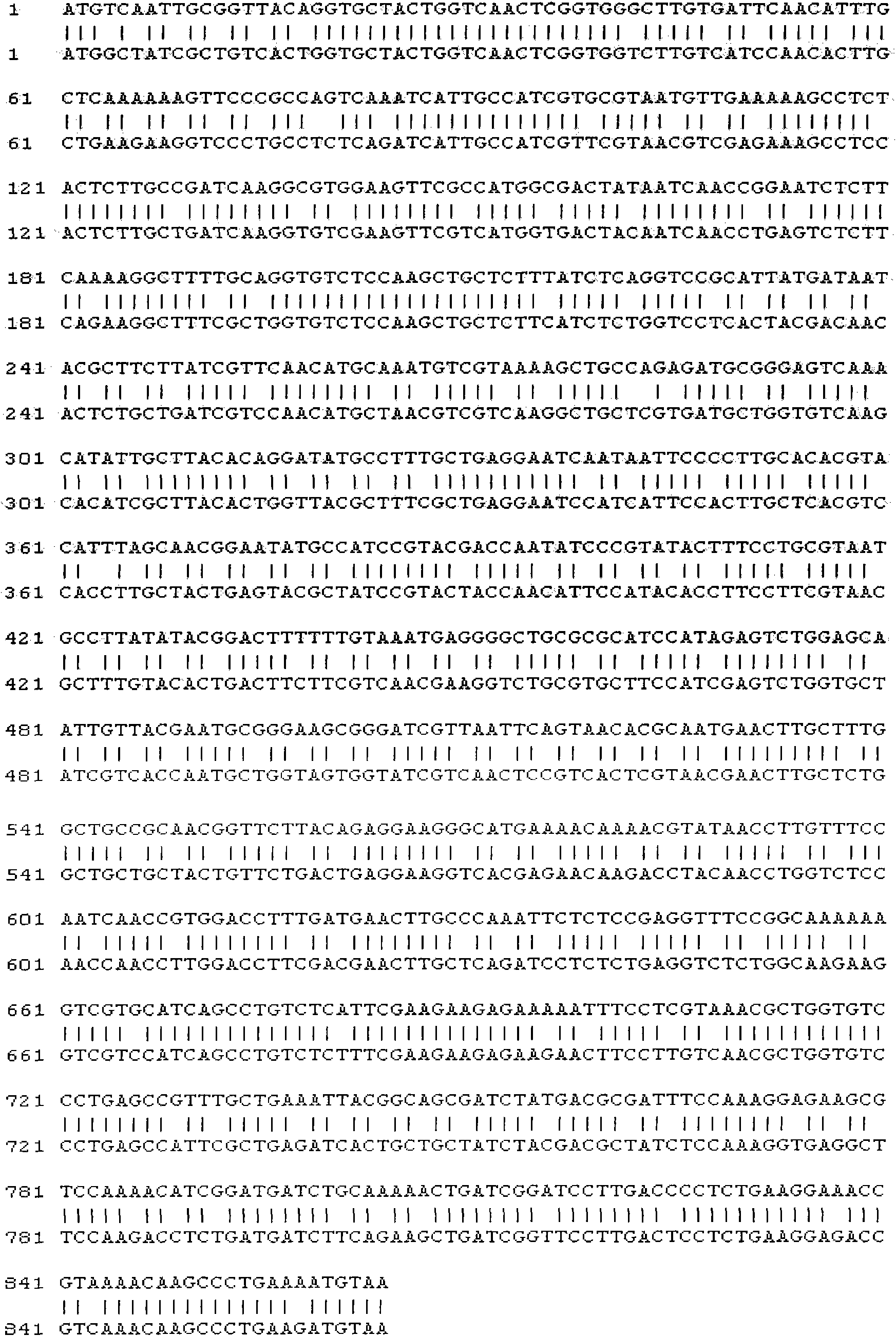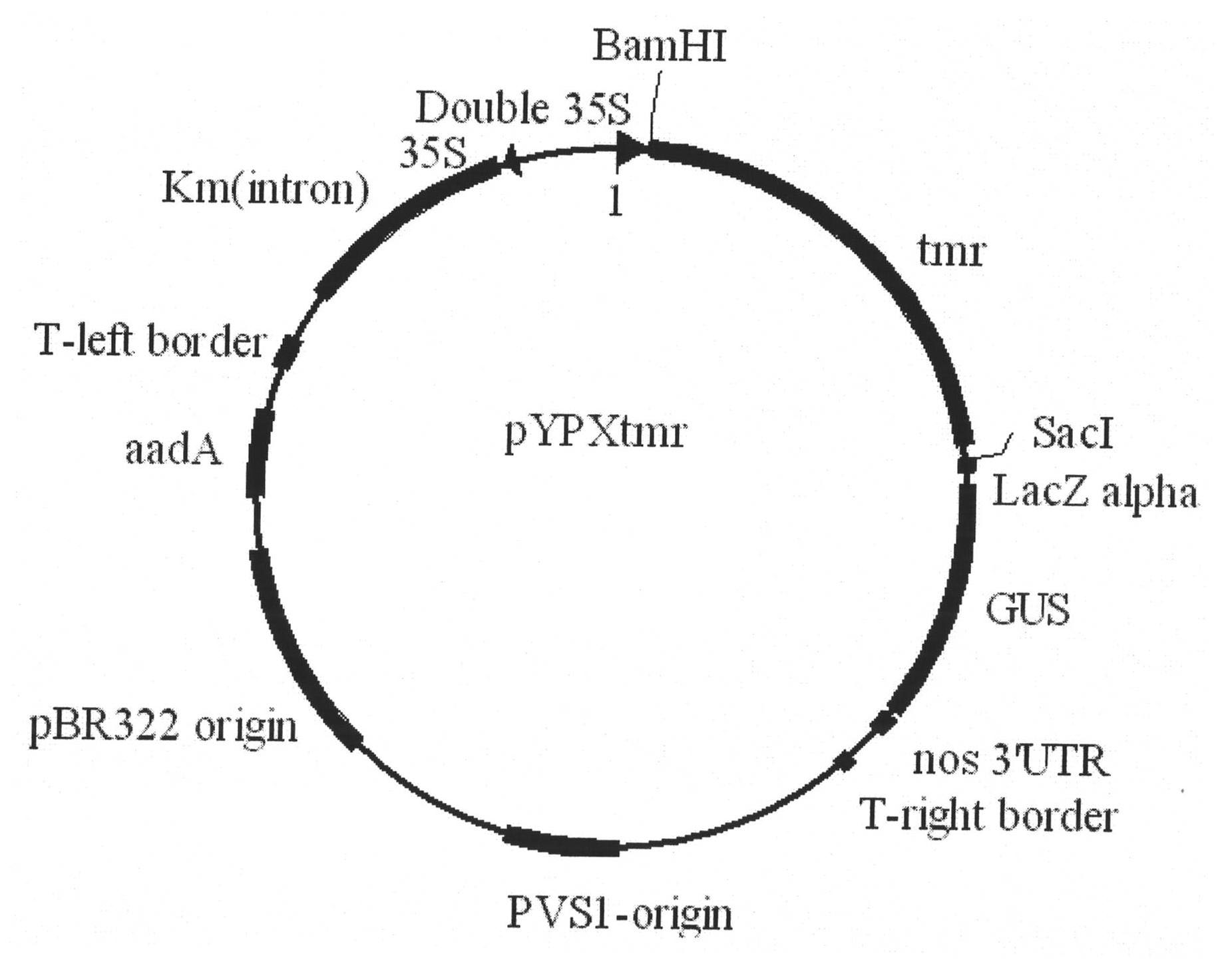Optimized triphenylmethane reductase gene as well as expression and application thereof
A technology of triphenylmethane and reductase, applied in the field of phytoremediation, to achieve the effect of less environmental pollution
- Summary
- Abstract
- Description
- Claims
- Application Information
AI Technical Summary
Problems solved by technology
Method used
Image
Examples
Embodiment 1
[0064] De novo synthesis of an optimized triphenylmethane reductase gene following the plant-preferred code
[0065] We re-synthesized the optimized triphenylmethane reductase gene according to the plant-preferred code, and compared the newly synthesized gene sequence with the original gene sequence ( figure 1 ). The optimized triphenylmethane reductase gene synthesis primers are as follows:
[0066] P1 ATGGCTATCGCTGTCACTGGTGCTACTGGTCAACTCGGTGGTCTTGTCATCCAACACTTTGCT
[0067] P2 TTACGAACGATGGCAATGATCTGAGAGGCAGGGACCTTCTTCAGCAAAGTGTTGGATGACAAGA
[0068] P3 AGATCATTGCCATCGTTCGTAACGTCGAGAAAGCCTTCCACTCTTGCTGATCAAGGTGTCGAA
[0069] P4 CTGAAAGAGACTCAGGTTGATTGTAGTCACCATGACGAACTTCGACACCTTGATCAGCAAG
[0070] P5 AACCTGAGTCTCTTTCAGAAGGCTTTCGCTGGTGTCTCCAAGCTGCTCTTCATCTCTGGTCCTCA
[0071] P6 CGACGTTAGCATGTTGGACGATCAGCAGAGTGTATGTCGTAGTGAGGACCAGAGATGAAGAGCAG
[0072] P7 CGTCCAACATGCTAACGTCGTCAAGGCTGCTCGTGATGCTGGTGCATAGCACATCGCTTACAC
[0073] P8 TGAGCAAGTGGAATGATGGATTCCCTCAGCGAAAGCGTAACC...
Embodiment 2
[0089] Construction of optimized plant expression vector for triphenylmethane reductase gene
[0090] The triphenylmethane reductase from Citrobacter was modified according to the plant-preferred code, and the gene was re-synthesized by gene synthesis method (Xiong 2004, Nucleic Acid Research).
[0091] Respectively use BamHI and SacI to carry out double enzyme digestion, recover the DNA fragments, connect the optimized triphenylmethane reductase gene with the pYPX245 plasmid containing double 35S promoters by T4 DNA ligase, purify, identify by enzyme digestion and sequence determination to obtain triphenylmethane reductase gene The recombinant plasmid vector pYPXtmr of methane reductase gene ( figure 2 ). The expression vector also contains a GUS reporter gene and a kanamycin resistance marker gene with an intron.
Embodiment 3
[0093] Agrobacterium cultivation and plant transformation
[0094] Agrobacterium strains are Agrobacterium tumefaciens EHA105, LBA4404, GV3101 strains. The plasmid was introduced into Agrobacterium by electroporation. Pick a single bacterium and culture it overnight in 25ml YEB medium (50mg / L rifampicin), transfer 5ml of the bacterial solution to 100ml YEB medium (50mg / L rifampicin), and cultivate it until OD600=0.7-0.8. Place on ice for 10 minutes, centrifuge at 5000rpm for 10min at 4°C, collect the bacteria, add 100ml sterile double distilled water to wash twice. Add 4ml of 10% glycerol to suspend the bacteria and transfer to a 50ml centrifuge tube. Centrifuge at 5500rpm for 10min at 4°C. Collect the bacteria, add 500 μl of 10% glycerol to suspend the bacteria, and transfer to a 1.5ml centrifuge tube. Take 70 μl of competent cells and add 1 μl of recombinant plasmid vector pYPXtmr. Mix well with a yellow pipette tip with the head removed, and transfer to a 0.1cm electri...
PUM
 Login to View More
Login to View More Abstract
Description
Claims
Application Information
 Login to View More
Login to View More - R&D
- Intellectual Property
- Life Sciences
- Materials
- Tech Scout
- Unparalleled Data Quality
- Higher Quality Content
- 60% Fewer Hallucinations
Browse by: Latest US Patents, China's latest patents, Technical Efficacy Thesaurus, Application Domain, Technology Topic, Popular Technical Reports.
© 2025 PatSnap. All rights reserved.Legal|Privacy policy|Modern Slavery Act Transparency Statement|Sitemap|About US| Contact US: help@patsnap.com



